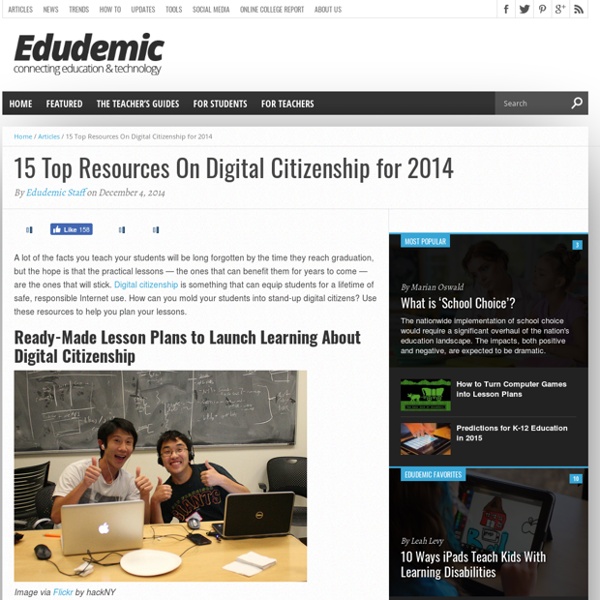theconversation
Have you seen the how-to video of a teenage girl styling her hair that went disastrously wrong? She was obviously very disturbed by what happened, yet still uploaded the footage onto YouTube. Do you think a 45 or 50 year-old would upload an equivalent video of themselves? The majority of young people now share lots of things online that many adults question and feel uncomfortable about: their likes, dislikes, personal views, who they’re in a relationship with, where they are, images of themselves and others doing things they should or maybe shouldn’t be doing.
Digital Citizenship Week: 6 Resources for Educators
Considering how ubiquitous smartphones and tablets have become, especially in high school and middle school, questions about managing use and educating students about digital etiquette are on a lot of educators' minds. This October, Common Sense Media is sponsoring Digital Citizenship Week from October 16 to October 22. And we wanted to pull together some of the best resources to help educators talk about digital responsibility and safety online.
Digital Citizenship Education in Nine Steps
Today’s students have an online playground in addition to the physical one at their schools. But unlike school playgrounds, digital spaces are rarely monitored or supervised. As students connect, communicate, and collaborate digitally, they need to learn web literacy, source evaluation, information filtering, and self-monitoring skills.
8 digital skills we must teach our children
The social and economic impact of technology is widespread and accelerating. The speed and volume of information have increased exponentially. Experts are predicting that 90% of the entire population will be connected to the internet within 10 years. With the internet of things, the digital and physical worlds will soon be merged. These changes herald exciting possibilities.
Forget coding, we need to teach kids about digital citizenry
"Stupid posts about embarrassing incidents or regrettable comments don't just go away because children grow up," writes Asher Wolf. Photo: Stocksy Growing up online is complicated.
10 Good Tips To Spot Fake News
April 15, 2017 A few days ago we shared with you a new Google feature that allows you to easily fact check online content. Today, we are sharing with you 10 good tips that will enable you to critically assess the veracity and credibility of online content (e.g. news stories). These are guidelines Facebook Help Centre provided for it users to help them spot fake news. However, these tips can also apply to any other type of content.
A dozen ways to teach ethical and safe technology use
From The Classroom Teacher's Technology Survival Guide A dozen ways to teach and promote ethical and safe technology use Responsible teachers recognize that schools must give students the understandings and skills they need to stay safe not just in school, but outside of school where most Internet use by young people occurs.
An Updated Digital Differentiation Model
This is part of a Digital Differentiation model, my way i of weaving a web of flexible tools together for teaching and learning. To keep the model relevant, frequent updates are required, as new tools and trends emerge. To access the most current resources, please click on the tab at the top of this blog: Digital Differentiation - Current Updating
Digital Footprint: not everyone is equal and why unis need to teach managing DF as a 21st century skill
Australians are among the most digitally connected in the world and young people spend a lot of time online. Most young Australians have an extensive digital footprint, especially university students. Digital footprints are created through interaction with the internet and social media. Increasingly, digital footprint management is an important career development skill and one that is vital to the professional opportunities of university students.
Why Our Learners Need Media Literacy in a Transforming World
Media literacy has become a more important consideration in our children’s futures than ever. It behooves educators to be familiar with media’s role in our changing world. Media is here to stay as a main component of how society shares information across a vast population quickly. While some teachers fear it, others are realizing the potential to reach more students through things that our digital natives are familiar with. When importance is given to finding and harnessing ways that students learn best, the modern teacher benefits as much as students. At the same time we must be addressing citizenship within the digital community.
5 Excellent Videos to Teach Your Students about Digital Citizenship
Edutopia is one of my favourite educational web resources . Today while I was checking its Five Minute Film Festival page I came across a link that took me to their YouTube channel where I found a treasure trove of interesting videos on digital citizenship and because digital citizenship is one of the important themes in this blog, I decided to handpick some of the clips that grabbed my attention and share them with you below , you can also check the entire list here. But before that, let me share with you this concise and to-the-point definition that Amy gave to digital citizenship : "Digital citizenship" is an umbrella term that covers a whole host of important issues. Broadly, it's the guidelines for responsible, appropriate behavior when one is using technology.
Digital Citizenship in the Real World
Digital Citizenship | Feature Digital Citizenship in the Real World The Digital Driver's License is helping students navigate the hazards of the Internet.



